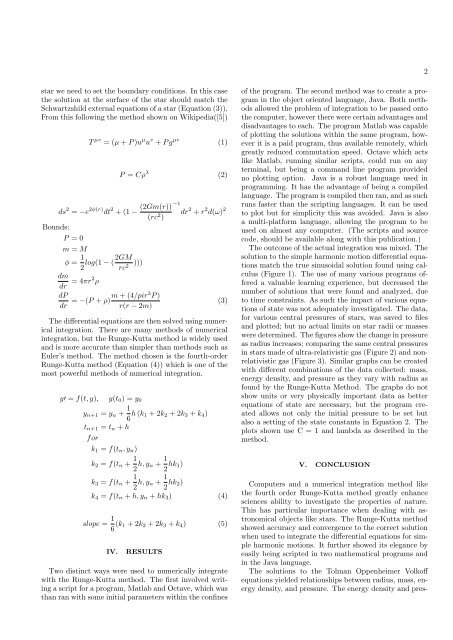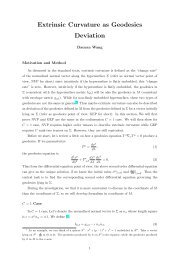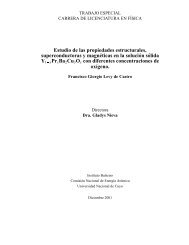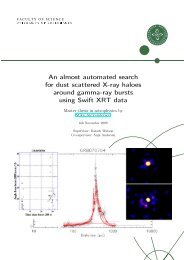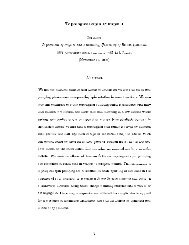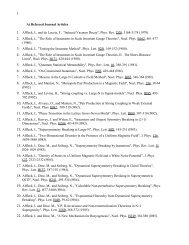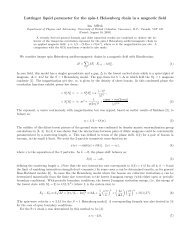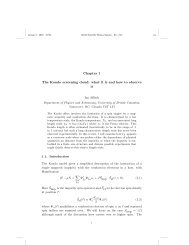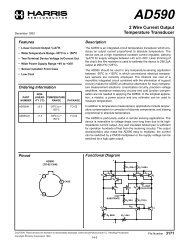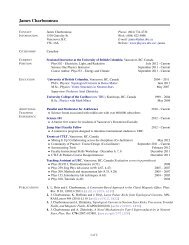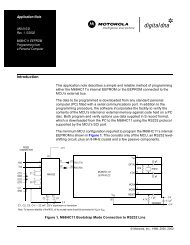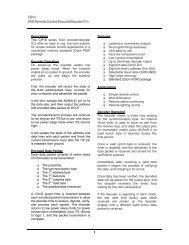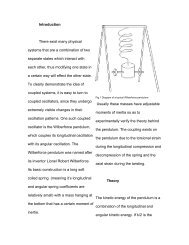Physics 210 paper on the Tolman-Oppenheimer-Volkoff Hydrostatic ...
Physics 210 paper on the Tolman-Oppenheimer-Volkoff Hydrostatic ...
Physics 210 paper on the Tolman-Oppenheimer-Volkoff Hydrostatic ...
You also want an ePaper? Increase the reach of your titles
YUMPU automatically turns print PDFs into web optimized ePapers that Google loves.
2<br />
star we need to set <strong>the</strong> boundary c<strong>on</strong>diti<strong>on</strong>s. In this case<br />
<strong>the</strong> soluti<strong>on</strong> at <strong>the</strong> surface of <strong>the</strong> star should match <strong>the</strong><br />
Schwartzshild external equati<strong>on</strong>s of a star (Equati<strong>on</strong> (3)).<br />
From this following <strong>the</strong> method shown <strong>on</strong> Wikipedia([5])<br />
T µv = (µ + P )u µ u v + P g µv (1)<br />
P = Cρ λ (2)<br />
ds 2 = −e 2φ(r) dt 2 + (1 − (2Gm(r)) −1<br />
(rc 2 dr 2 + r 2 d(ω) 2<br />
)<br />
Bounds:<br />
P = 0<br />
m = M<br />
φ = 1 log(1 − (2GM<br />
2 rc 2 )))<br />
dm<br />
dr = 4πr2 ρ<br />
dP<br />
dr = −(P + ρ)m + (4/pir3 P )<br />
r(r − 2m)<br />
(3)<br />
The differential equati<strong>on</strong>s are <strong>the</strong>n solved using numerical<br />
integrati<strong>on</strong>. There are many methods of numerical<br />
integrati<strong>on</strong>, but <strong>the</strong> Runge-Kutta method is widely used<br />
and is more accurate than simpler than methods such as<br />
Euler’s method. The method chosen is <strong>the</strong> fourth-order<br />
Runge-Kutta method (Equati<strong>on</strong> (4)) which is <strong>on</strong>e of <strong>the</strong><br />
most powerful methods of numerical integrati<strong>on</strong>.<br />
y′ = f(t, y), y(t 0 ) = y 0<br />
y n+1 = y n + 1 6 h (k 1 + 2k 2 + 2k 3 + k 4 )<br />
t n+1 = t n + h<br />
for<br />
k 1 = f(t n , y n )<br />
k 2 = f(t n + 1 2 h, y n + 1 2 hk 1)<br />
k 3 = f(t n + 1 2 h, y n + 1 2 hk 2)<br />
k 4 = f(t n + h, y n + hk 3 ) (4)<br />
slope = 1 6 (k 1 + 2k 2 + 2k 3 + k 4 ) (5)<br />
IV.<br />
RESULTS<br />
Two distinct ways were used to numerically integrate<br />
with <strong>the</strong> Runge-Kutta method. The first involved writing<br />
a script for a program, Matlab and Octave, which was<br />
than ran with some initial parameters within <strong>the</strong> c<strong>on</strong>fines<br />
of <strong>the</strong> program. The sec<strong>on</strong>d method was to create a program<br />
in <strong>the</strong> object oriented language, Java. Both methods<br />
allowed <strong>the</strong> problem of integrati<strong>on</strong> to be passed <strong>on</strong>to<br />
<strong>the</strong> computer, however <strong>the</strong>re were certain advantages and<br />
disadvantages to each. The program Matlab was capable<br />
of plotting <strong>the</strong> soluti<strong>on</strong>s within <strong>the</strong> same program, however<br />
it is a paid program, thus available remotely, which<br />
greatly reduced commutati<strong>on</strong> speed. Octave which acts<br />
like Matlab, running similar scripts, could run <strong>on</strong> any<br />
terminal, but being a command line program provided<br />
no plotting opti<strong>on</strong>. Java is a robust language used in<br />
programming. It has <strong>the</strong> advantage of being a compiled<br />
language. The program is compiled <strong>the</strong>n ran, and as such<br />
runs faster than <strong>the</strong> scripting languages. It can be used<br />
to plot but for simplicity this was avoided. Java is also<br />
a multi-platform language, allowing <strong>the</strong> program to be<br />
used <strong>on</strong> almost any computer. (The scripts and source<br />
code, should be available al<strong>on</strong>g with this publicati<strong>on</strong>.)<br />
The outcome of <strong>the</strong> actual integrati<strong>on</strong> was mixed. The<br />
soluti<strong>on</strong> to <strong>the</strong> simple harm<strong>on</strong>ic moti<strong>on</strong> differential equati<strong>on</strong>s<br />
match <strong>the</strong> true sinusoidal soluti<strong>on</strong> found using calculus<br />
(Figure 1). The use of many various programs offered<br />
a valuable learning experience, but decreased <strong>the</strong><br />
number of soluti<strong>on</strong>s that were found and analyzed, due<br />
to time c<strong>on</strong>straints. As such <strong>the</strong> impact of various equati<strong>on</strong>s<br />
of state was not adequately investigated. The data,<br />
for various central pressures of stars, was saved to files<br />
and plotted; but no actual limits <strong>on</strong> star radii or masses<br />
were determined. The figures show <strong>the</strong> change in pressure<br />
as radius increases; comparing <strong>the</strong> same central pressures<br />
in stars made of ultra-relativistic gas (Figure 2) and n<strong>on</strong>relativistic<br />
gas (Figure 3). Similar graphs can be created<br />
with different combinati<strong>on</strong>s of <strong>the</strong> data collected: mass,<br />
energy density, and pressure as <strong>the</strong>y vary with radius as<br />
found by <strong>the</strong> Runge-Kutta Method. The graphs do not<br />
show units or very physically important data as better<br />
equati<strong>on</strong>s of state are necessary, but <strong>the</strong> program created<br />
allows not <strong>on</strong>ly <strong>the</strong> initial pressure to be set but<br />
also a setting of <strong>the</strong> state c<strong>on</strong>stants in Equati<strong>on</strong> 2. The<br />
plots shown use C = 1 and lambda as described in <strong>the</strong><br />
method.<br />
V. CONCLUSION<br />
Computers and a numerical integrati<strong>on</strong> method like<br />
<strong>the</strong> fourth order Runge-Kutta method greatly enhance<br />
sciences ability to investigate <strong>the</strong> properties of nature.<br />
This has particular importance when dealing with astr<strong>on</strong>omical<br />
objects like stars. The Runge-Kutta method<br />
showed accuracy and c<strong>on</strong>vergence to <strong>the</strong> correct soluti<strong>on</strong><br />
when used to integrate <strong>the</strong> differential equati<strong>on</strong>s for simple<br />
harm<strong>on</strong>ic moti<strong>on</strong>s. It fur<strong>the</strong>r showed its elegance by<br />
easily being scripted in two ma<strong>the</strong>matical programs and<br />
in <strong>the</strong> Java language.<br />
The soluti<strong>on</strong>s to <strong>the</strong> <strong>Tolman</strong> <strong>Oppenheimer</strong> <strong>Volkoff</strong><br />
equati<strong>on</strong>s yielded relati<strong>on</strong>ships between radius, mass, energy<br />
density, and pressure. The energy density and pres-


